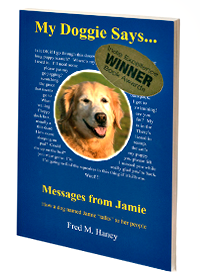I am constantly aware of Doc O’s admonition that “everyone would want a dog just like Jamie. But it will be a another spirit, another life, another joy.” As Callie (now a six-months-old Golden Retriever) grows up, I work hard at understanding who she is and not expecting her to be like Jamie (the heroine of My Doggie Says… Messages From Jamie. How a dog named Jamie “talks” to her people).
Unlike Jamie, Callie has established that she is a “ball dog.” She really like to play with balls, but Jamie didn’t. If you threw a ball to Jamie, she would just let it hit her on the nose. But Callie really cares about balls. In the next blog or two, you will see some video of Callie playing soccer, which she loves to do. This morning, one of Callie’s under-sized tennis balls fell into a little patch of ivy in our side yard, and Callie went diving in to the ivy and poked around until she found her ball. Jamie would not have done that. So what’s the lesson? I’m trying to nurture Callie’s interest in balls — partly by playing soccer with her whenever I can. Callie also likes to “borrow” golf balls when I’m practicing around the house.
Another difference between Callie and Jamie seems to be their interest in watching TV. Jamie glanced at the TV once in a while, but Callie really seems to lock in, for a few seconds anyway, on what’s going on. Yesterday, we were watching the British Open on TV, and Sergio Garcia hit a shot that rolled up onto the green. Callie saw the little white ball rolling, and she absolutely tried, with her mouth, to pick it up. She followed it all the way across the putting green. Then, when the ball came to rest in the lower right corner of our TV set, she focused on trying to pick up the round “ABC” TV logo. This just lasted a few seconds, and she was off to something else. But she does seem to have a pattern of checking in to see what’s happening on the TV, once in a while, in one of those rare moments, when it’s turned on.
Here’s an interesting article that says that “87% of dog owners believe that their pets watch television. A survey by the American Kennel Club and Iams found that nearly half of dogs surveyed showed some interest in what was happening on the television.” Another article, on seefido.com, points out that TV doesn’t appeal to dogs’ sense of smell, which is a very important part of their sensory input. So if the networks want to add dogs to their listener audience, they need to find a way for TV to impart a sense of smell. Can you imagine how much TV your dog would watch if it could smell the dog food, or the sizzling steaks in advertisements?












